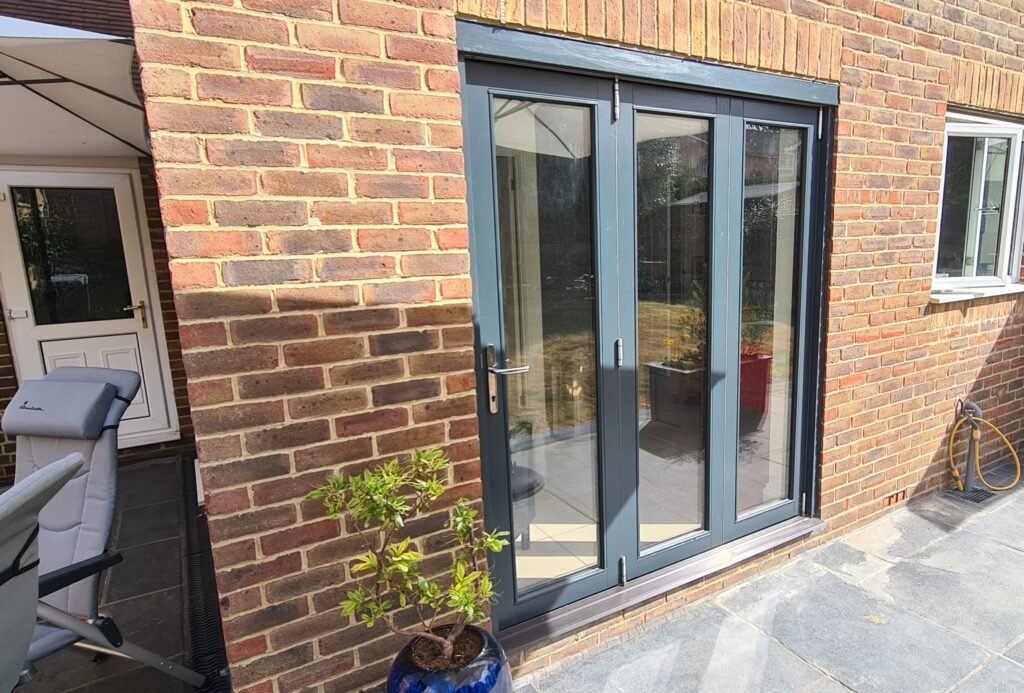[ad_1]
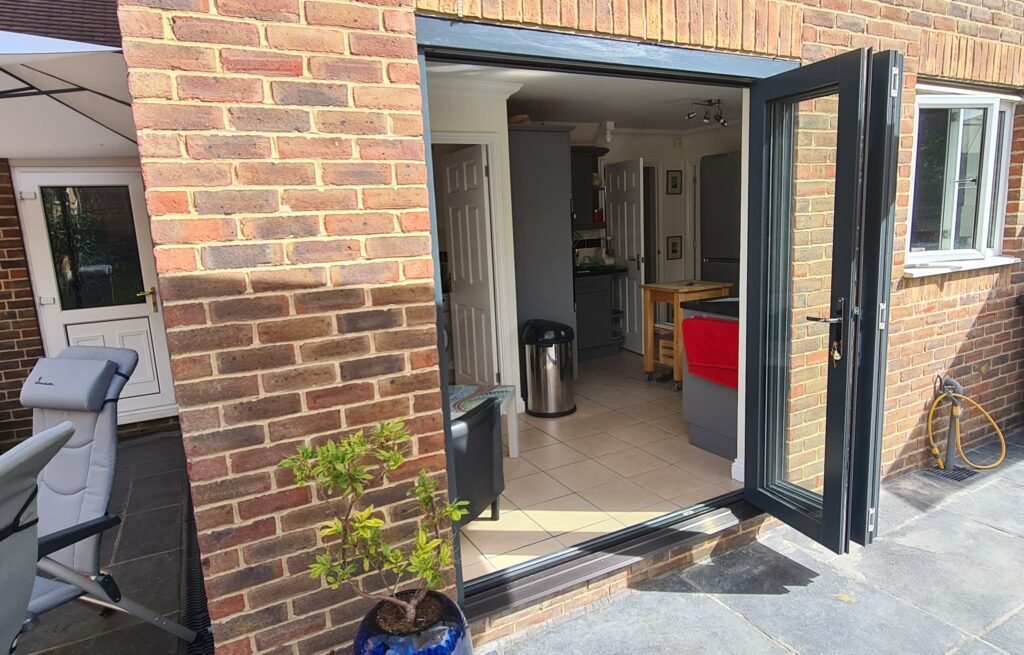
Pre-purchase selections
Bifold doorways are an attractive addition to any dwelling and might deliver the skin in however there are some issues I needed to contemplate earlier than deciding to go forward and exchange my present patio doorways with bifold doorways.
Doorways and home windows are a managed set up and subsequently require that the installer is both FENSA registered or that the particular person putting in the doorways and home windows will let constructing management know earlier than the set up or get a Certificates of Regularisation if making use of to constructing management retrospectively.
This weblog publish data my expertise of putting in Jeld-Wen Bedgebury bifold doorways as a alternative for outdated uPVC sliding patio doorways.
Assessing the lintel
The present opening of the outdated patio doorways was the identical dimension as that required for the alternative bifold doorways. If it had not have been then there may have been a number of difficult alterations to the lintel above the door and the encircling brickwork. This is able to contain acrow props and short-term beams and would most undoubtedly have required consulting the professionals. The opening being the best dimension for the brand new doorways didn’t imply that I may take the lintel requirement with no consideration. I nonetheless needed to assess the loading rquirements to verify the lintel was able to accepting the additional load of the brand new bifold doorways. This may differ by producer and door sort i.e., high hung, backside hung, uPVC, hardwood and many others. The directions for the doorways ought to specify a Uniformly Distributed Load or UDL which is expressed in Kilo-Newtons per metre.
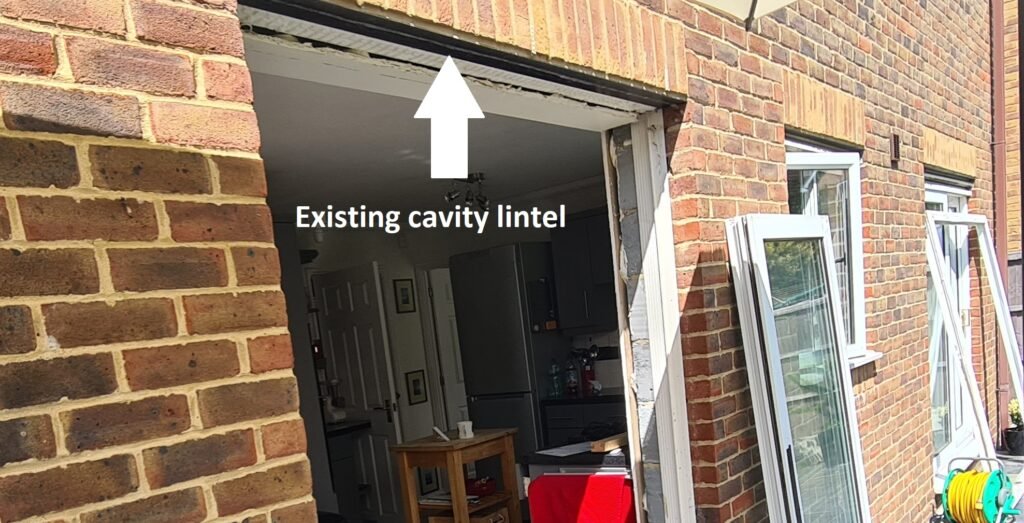
In my case the Jeld Wen Bedgebury 3 door 1800mm large bifold doorways had been described within the directions as having a UDL of 0.5KN. The present cavity lintel was a heavy-duty sort made out of metal with a cloth thickness of 3mm and the tip bearing onto the brickwork (how a lot the lintel overhangs the opening) was 150mm which is the minimal prescribed by the Jeld-Wen directions. On this case it was assessed that the prevailing lintel had a load which was equal to that of a typical load state of affairs for a single-family residential dwelling room. This equates to a load of a typical timber flooring utilized to the lintel, through joists resting on the lintel or on the masonry instantly above the lintel. As a information, the next building offers the above lifeless load: Typical 50x220mm I Beam Composite joists at 400mm centres, 18mm chipboard flooring, underlay & carpet, 13mm plasterboard ceiling with finishes, partitions (non-load-bearing stud partitions) and providers/built-ins similar to typical plumbing, storage cabinets, sinks & lights. This reside load is typical for a extra extremely loaded home room flooring. (Refer BS 6399) This provides a complete lintel load of 6.0kN/m, which is taken over 1.1x the clear opening span for the load tables, as per BS 5977-1.
Load Particulars:
– Useless load of 1.0 kN/m2
– Reside load of two.0 kN/m2
– Joist span of 4.0m in complete
– Giving 6.0kN/m on the lintel
Since Jeld-Wen specify a UDL of 0.5kN which might add a further load to the prevailing cavity lintel of roughly 8.5% which was deemed to be inside tolerance for the kind of cavity lintel which was current in my set up.
Checking the match
The doorways had been listed as being 1794mm large and 2094mm excessive. Jeld-Wen really helpful a +10mm tolerance for the dimensions of the opening. We measured the ends and center of the opening for top and width. My opening gave a width of 1804mm within the center and 1800mm on the high and backside and 2090mm throughout the complete top of the opening however we knew we had the power to take away a few of the mortar under the prevailing sill so we may get the required dimension. We checked the diagonal sizes as properly to substantiate we may get a real set up of the body i.e., all sides (left, proper, high and backside) parallel and straight.
As soon as the doorways have landed
The doorways are delivered in separate packing containers with the body in items in their very own field able to be made-up. The fixtures and fittings are additionally in a separate field with the with the screws and packers in their very own bag. There’s a set of directions on the Jeld-Wen web site that additionally comprise a equipment checklist. I spent a while verifying that all the things within the equipment checklist was contained throughout the components delivered by Jeld-Wen.
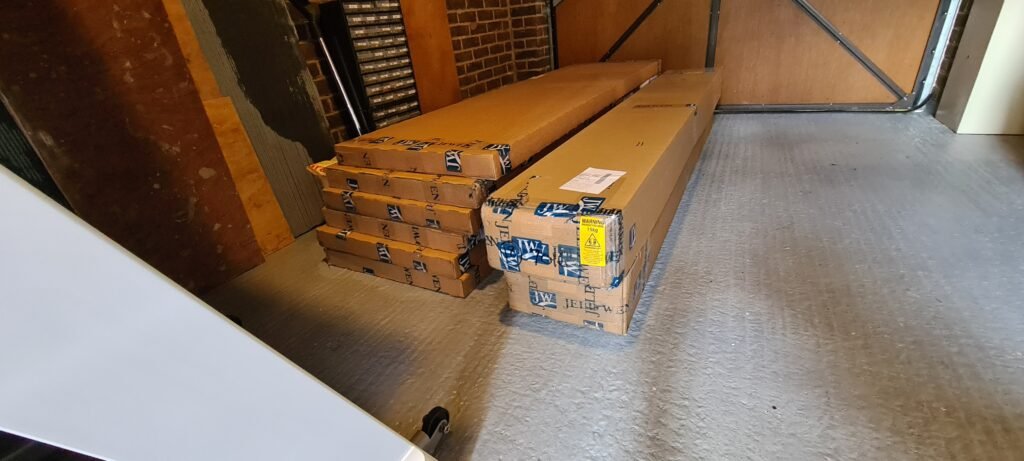
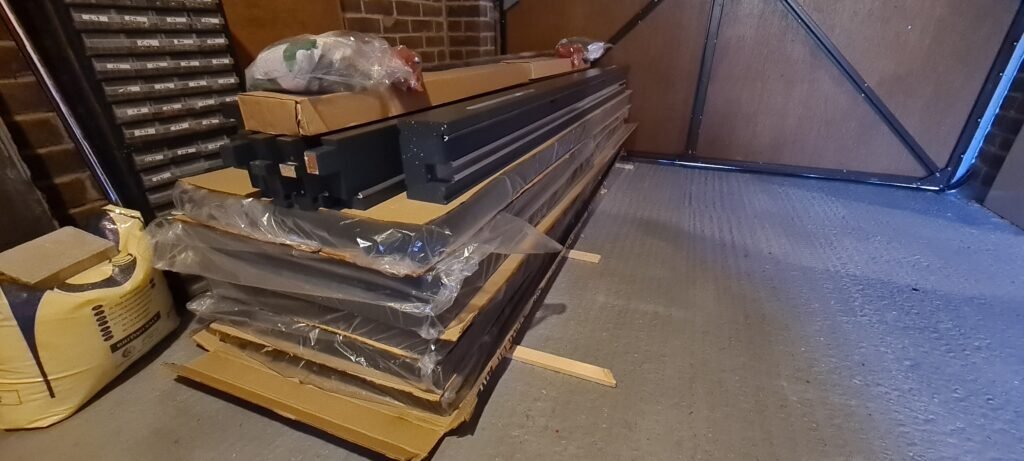
Though two units of the identical door had been ordered one set had an addendum sheet tucked into one of many body packing containers saying that sealant wanted to be utilized to the faces of the body joints. The opposite body got here with rubber pads caught to the faces of the joints which negated the necessity for sealant to be utilized and subsequently no addendum sheet. Fortunately, I unpacked the field with the addendum sheet first.
I made a decision which manner around the doorways ought to open and in my case the choice was pushed by the necessity to maximise the view out to the backyard and to present minimal interference with the visitors across the patio. At this stage I learn by means of the becoming directions equipped by Jeld-Wen on-line and made myself very acquainted with the set up course of and necessities. It’s price spending a while going by means of the directions step-by-step as this might save a variety of time in a while and in addition stop pricey errors. I additionally discovered some Jeld-Wen youtube movies that documented the becoming course of and gave some perception into areas that may want particular care and a focus.
The doorways got here with the multipoint locks spherical the best manner for my configuration however I may need needed to flip them if I had wished to put in the doorways opening the opposite manner and with the hinges on the alternative body jamb.
Demo Day
First job was to unscrew all of the fixtures and fittings from the outdated patio doorways and take away them from the opening. As a lot of the structural integrity as attainable was retained of the outdated patio doorways to permit them to be reinstalled within the opening if the brand new patio doorways weren’t prepared to put in on the finish of the day.
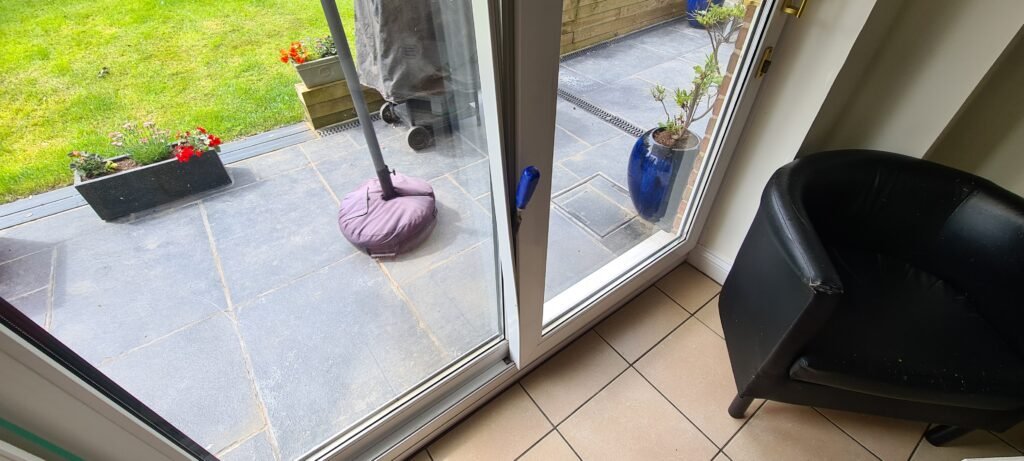
The door casements of the outdated patio doorways lifted out of the tracks with out an excessive amount of trouble as soon as the decrease plates had been unscrewed from the skin, not very safe. One thing the brand new Jeld-Wen bifold doorways is not going to endure from.
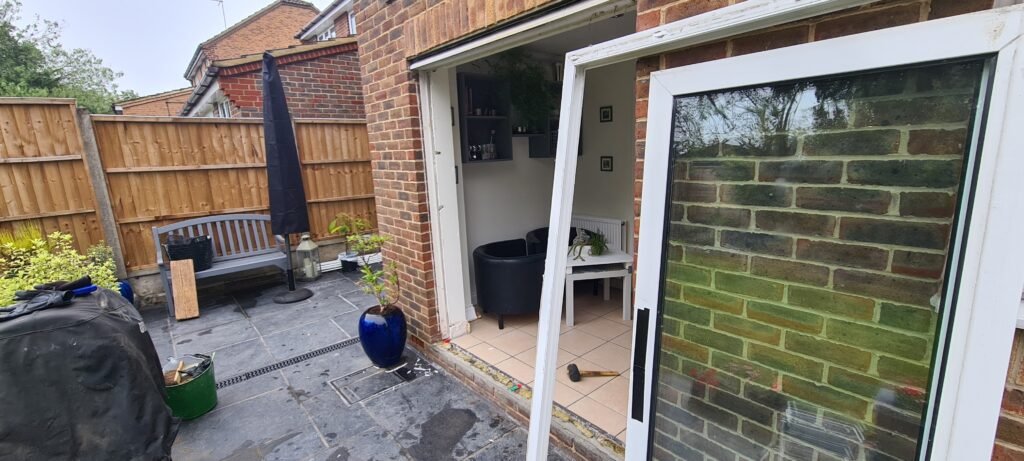
Some drywall needed to be eliminated to get to the body of the outdated patio doorways. The builders had used doorways the place the body was mounted to some specifically made plastic cavity closures. I’m certain this was achieved for quickness however does appear to lack a little bit of structural integrity and the closers didn’t comprise any insulation. Newer variations of those structural cavity closers have fixings into the blockwork to safe them and comprise insulation to present the proper thermal barrier.
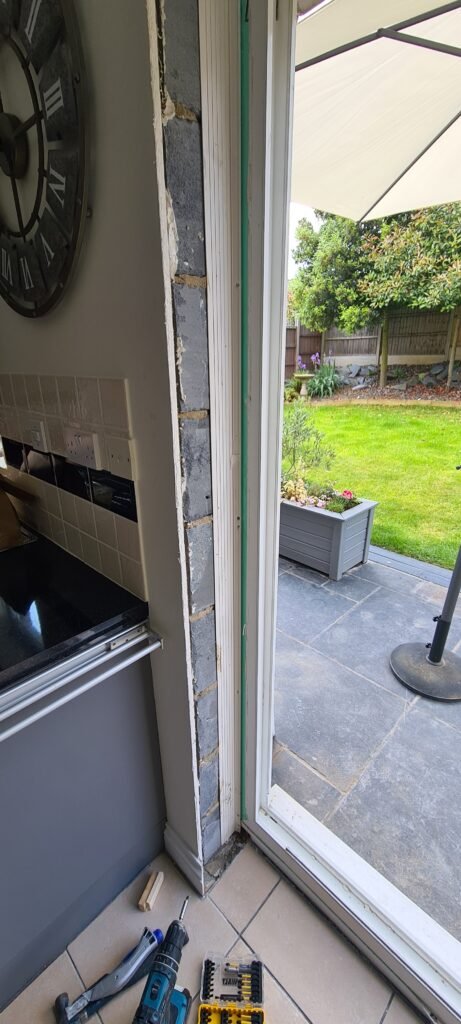
Adjusting the opening
As soon as the outdated patio doorways had been eliminated it was time to show my consideration to the opening. The brand new patio doorways sit again barely additional within the opening than the outdated ones requiring {that a} strip of tile and subfloor to be eliminated to accomodate the brand new bifiold doorways. The unique builders had stuffed the cavity beneath the outdated sill with concrete, so it was only a case of working an angle grinder alongside the tile to the required depth and width after which utilizing a chilly chisel the concrete, subfloor and tile was knocked out.
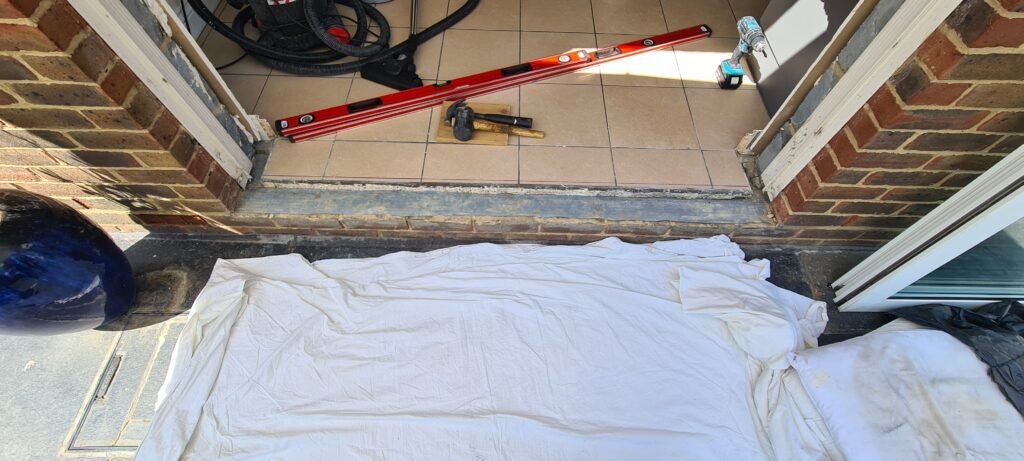
The sill on the brand new bifold doorways is secured with metallic strips so three holes had been minimize within the tile and subfloor prepared to permit the metallic strips to be sunk to the proper depth and screwed into the concrete subfloor under.
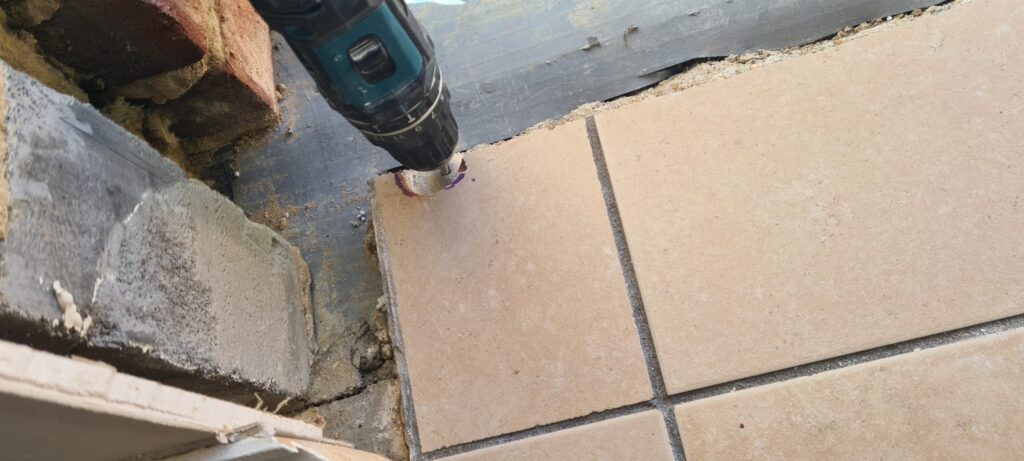
A clean mortar mattress was laid throughout the concrete under the place the brand new sill was going to make it degree prepared to simply accept the packers that might be used to repair the brand new sill on the appropriate top and degree. A chunk of DPC was laid throughout the mortar mattress to go beneath the sill. It was overlapped on the ground and the outside and can be minimize right down to dimension ultimately throughout the making good on the finish.
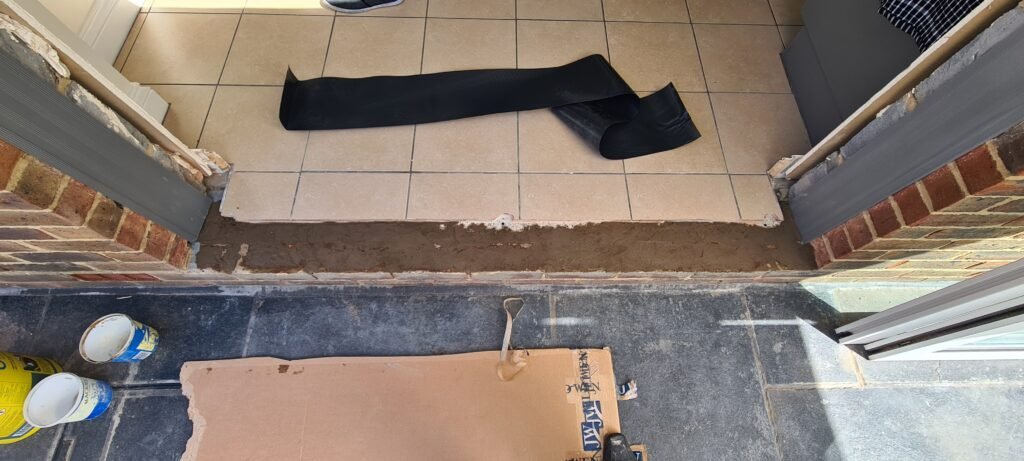
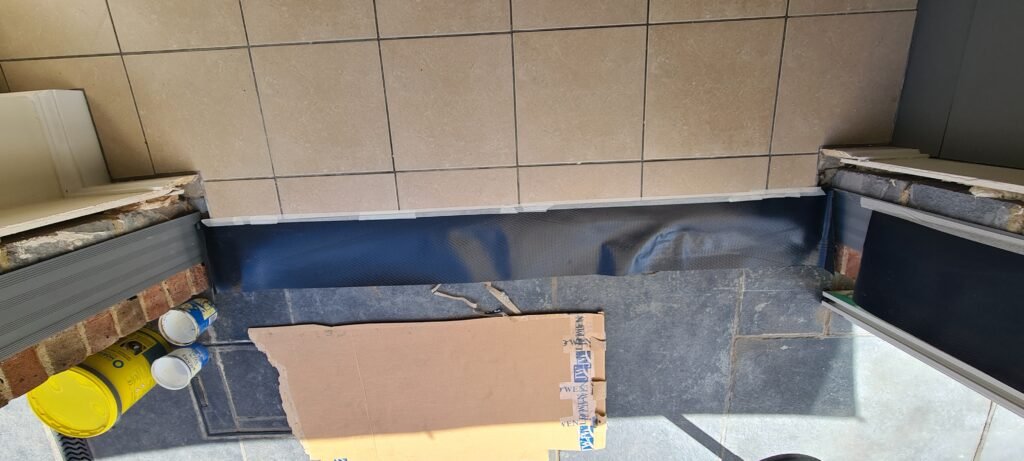
Establishing the body
It was now time to make the body up and supply it up into the opening to see how a lot if any work wanted doing to the opening to get the body to suit sq. and true. The body head of the Jeld-Wen doorways has holes pre-drilled with the positions of the screws that will likely be inserted into the lintel and blockwork above. Surprisingly although they don’t seem to be of a sufficiently big diameter to simply accept the lintel screws which can be equipped with the doorways, so the primary job is to drill the holes out to a diameter simply sufficiently big to permit the lintel screws to move by means of. The lintel screws that had been equipped in my pack had been blended and had two completely different diameters, so I made all of the holes to the dimensions of the most important diameter lintel screw.
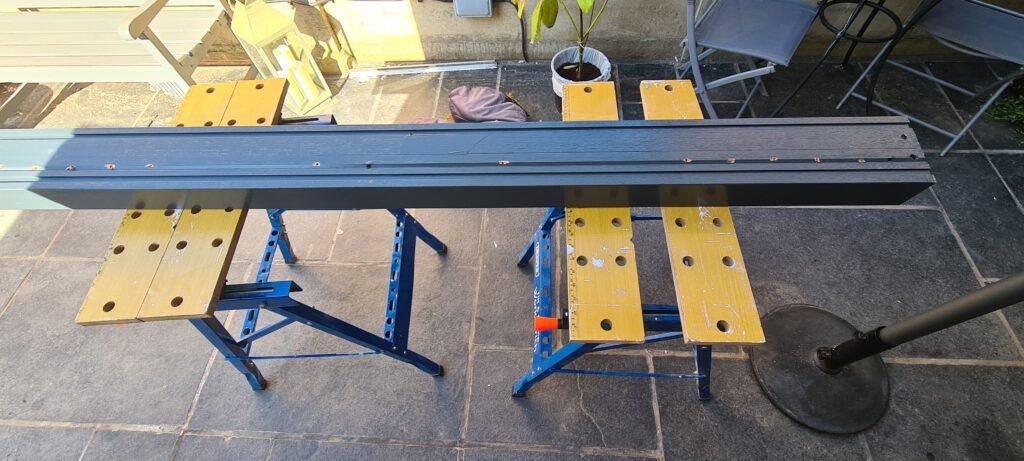
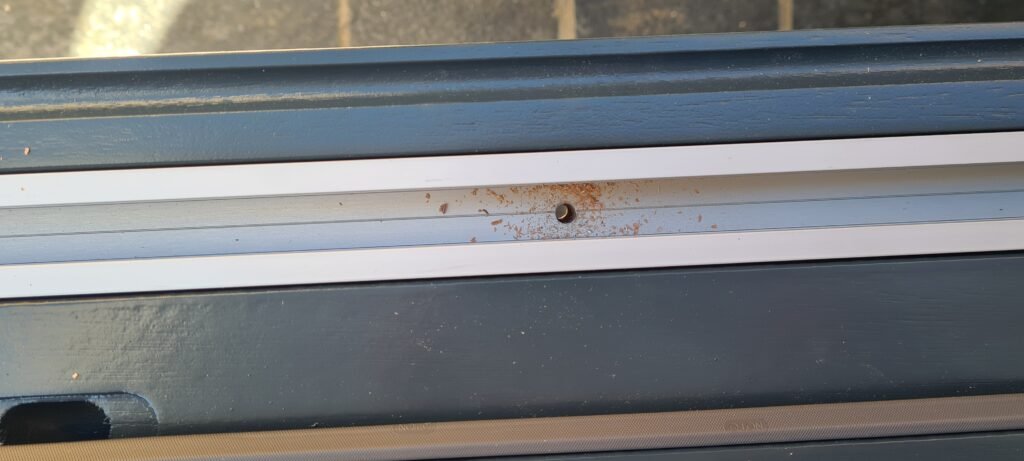
That is the place my sequence of building differed barely to that of the official Jeld-Wen model within the directions. The explanation for it is because the underside pivot block is screwed into the sill utilizing a pre-drilled pilot gap subsequently it’s critical that the block is precisely situated over the outlet to provide a agency and sq. fixing, and this might not be the case if the jamb is fitted into the sill a fraction of a millimetre out of alignment and doesn’t butt as much as the pivot block completely. So, I fitted the underside pivot hinge block by sliding it into the gully within the sill and aligning the outlet within the block with the pre-drilled gap within the sill and driving dwelling the screw. I did use a barely smaller screw than the one which was equipped within the pack because the origianal screw equipped by Jeld-Wen sheared off once I was screwing it in. Fixing the underside pivot block in place first permits the body jamb to be butted as much as it and subsequently precisely positioned when developing the body.
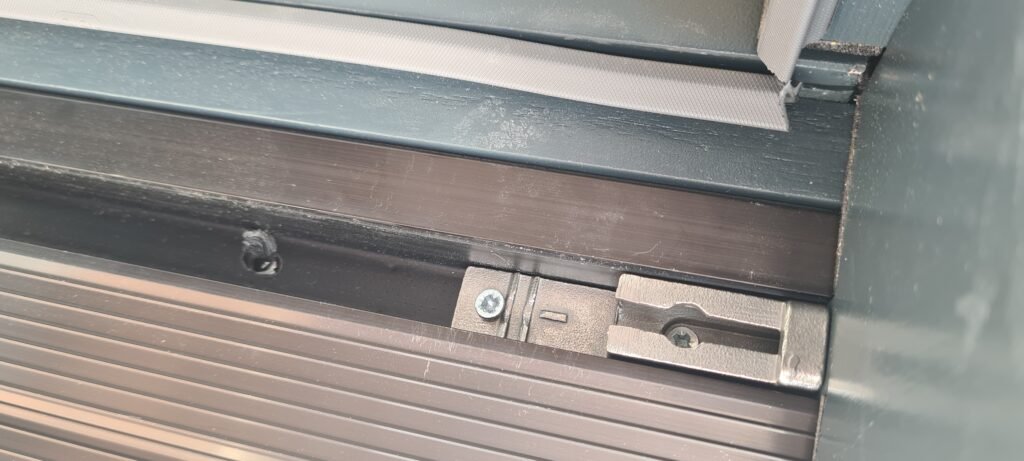
With the body head screw holes enlarged and backside pivot block in place it was time to screw the body collectively. We had been putting in two units of doorways as talked about earlier one set got here with an addendum specifying that silicone needed to be utilized to al the mating faces of the body joints. The opposite set of doorways had rubber pads on the mating faces so didn’t want silicone. I needed to minimize the climate seal at both finish of the top because it protruded past the place the jamb can be fitted.
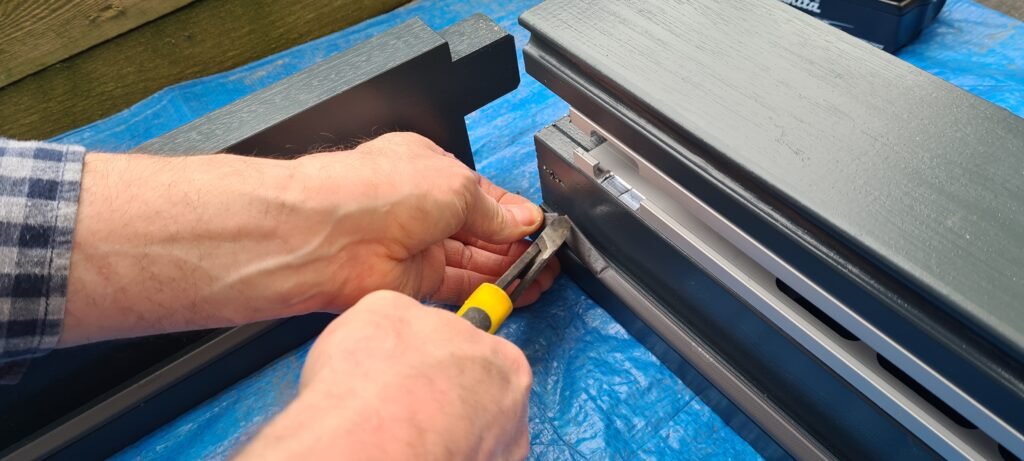
On the primary set of doorways to be put in they didn’t require silicone on the joint faces as a result of the body jambs had rubber gaskets utilized to them. It was now time to push the joints into their respective housings and make up the body. I discovered it simpler to raise the body off the ground utilizing blocks of wooden. This made it simpler to faucet the edges, head and sill collectively utilizing a rubber mallet.
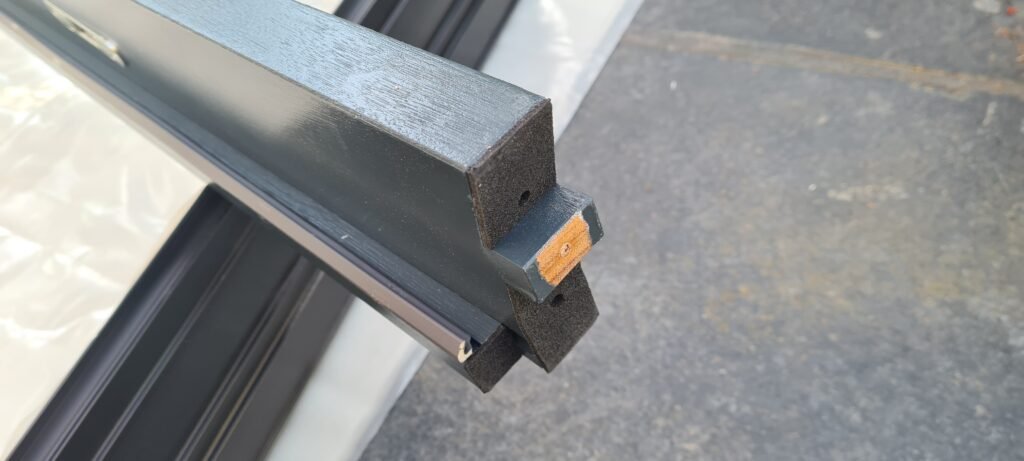
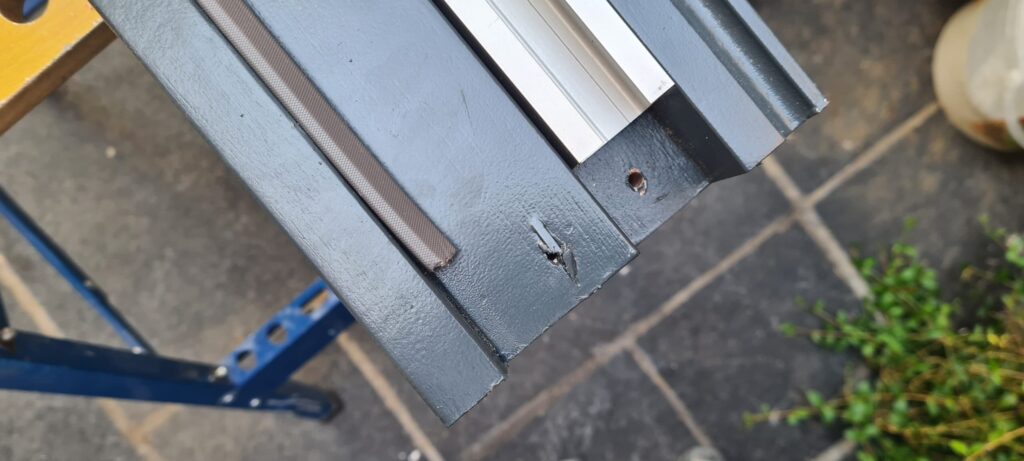
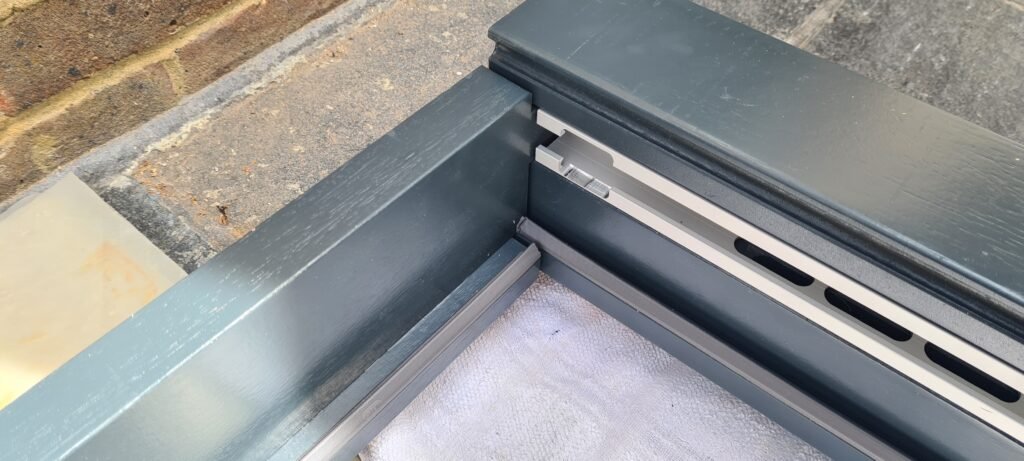
As soon as all of the body items had been collectively, I checked the trueness with a sq. earlier than inserting the body screws into the pre-drilled holes supplied by Jeld-Wen within the body and driving them dwelling with an electrical driver/drill.
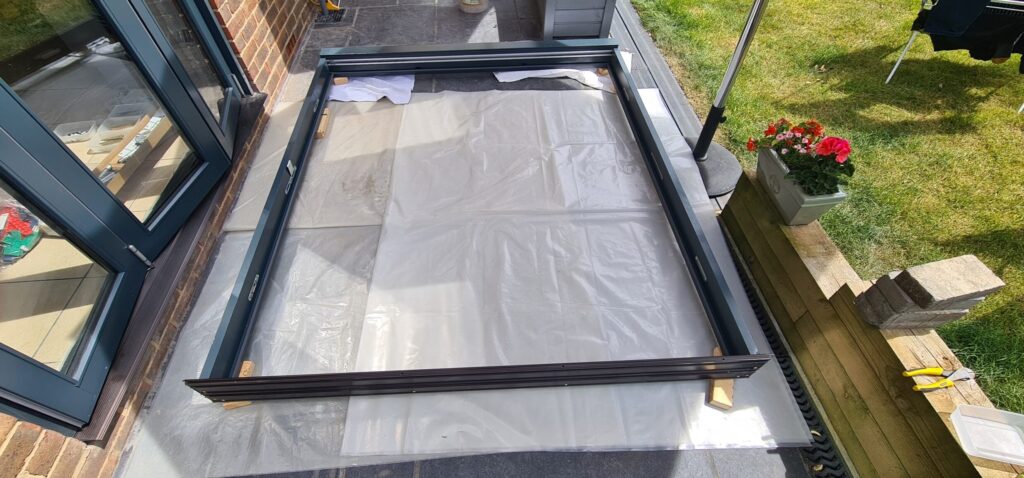
Closing up the cavity and body set up
The brand new cavity closers had been minimize to the proper size and inserted into the cavity. They’ve an adjustable insulation strip that you just cutdown with a Stanley knife to the width of the cavity between the blockwork and brickwork. The closers then have an interference match within the cavity in order that they are often pulled out and in fairly simply.
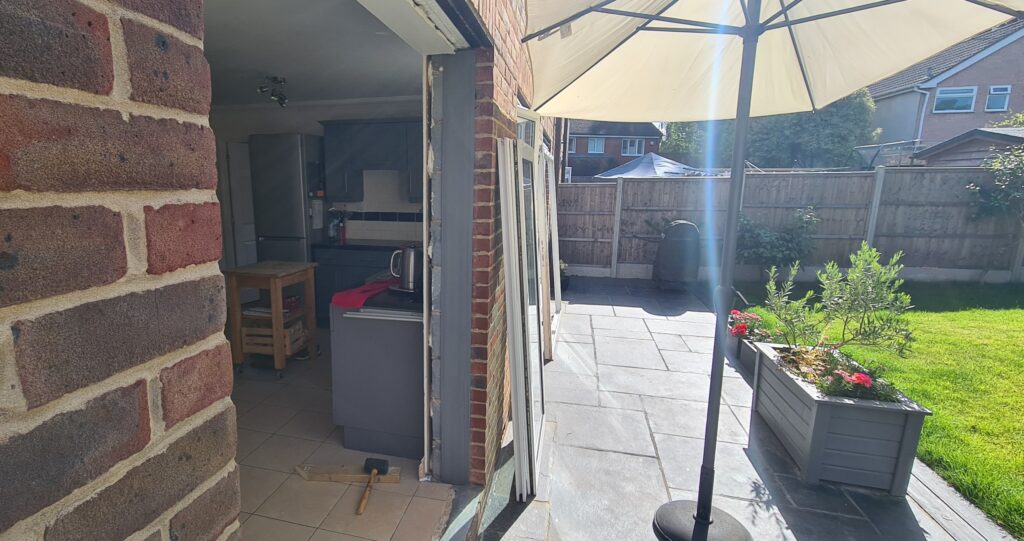
At this level I wanted the assistance of a second particular person to lift-up the body and supply it up into the opening. The body was fairly tight on the edges on the high so I took out the cavity closers and used an angle grinder to shave a small quantity off the brickwork to accommodate the body extra simply. This is able to additionally enable me a bit of little bit of leeway to regulate the body with packers when squaring it up.
With the body now with the ability to match properly into the opening I repositioned the cavity closers and we re-inserted the body into the opening. I made certain the lintel was 1mm happy with the top of the body all the way in which alongside and this additionally gave me about 35mm of reveal for the brickwork across the body.
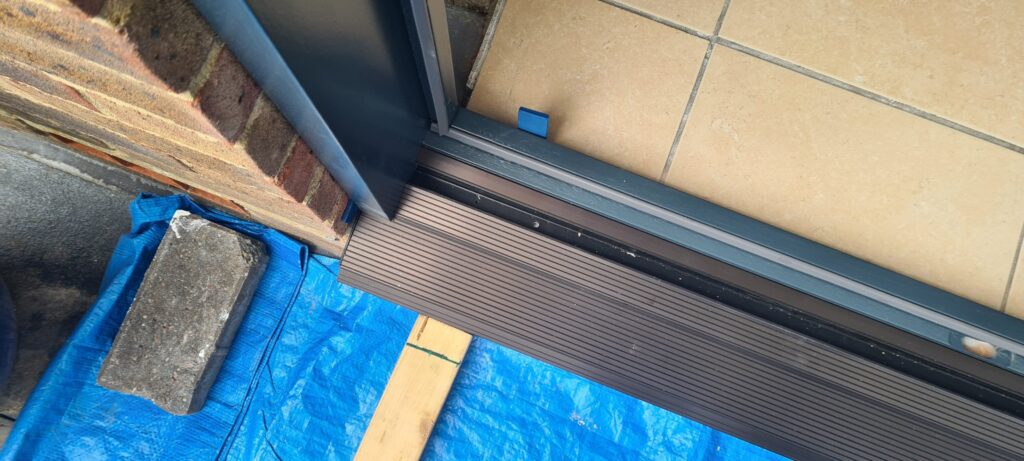
Utilizing an extended spirit degree I checked the edges, head and sill to verify they had been true and adjusted with body packers as obligatory and made a word of what number of and the place the packers had been inserted so I may simply true up the body once more after I had eliminated and reinserted it.
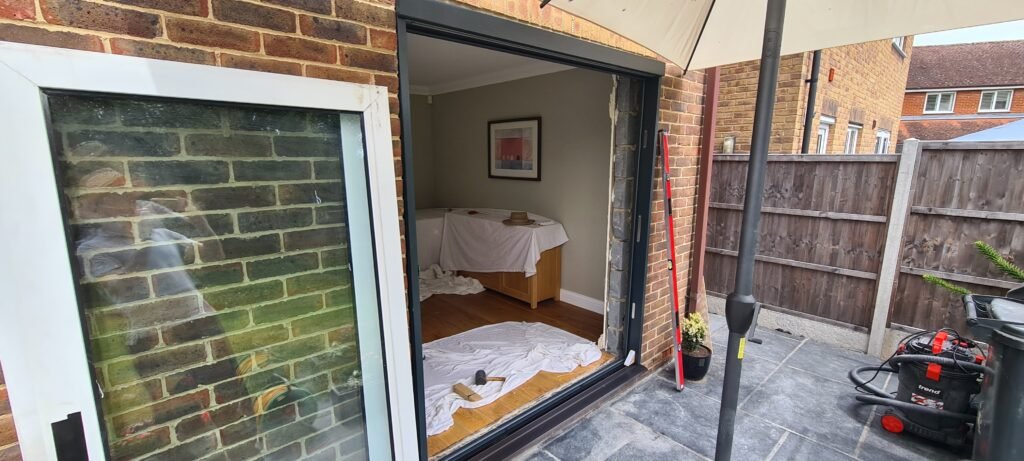
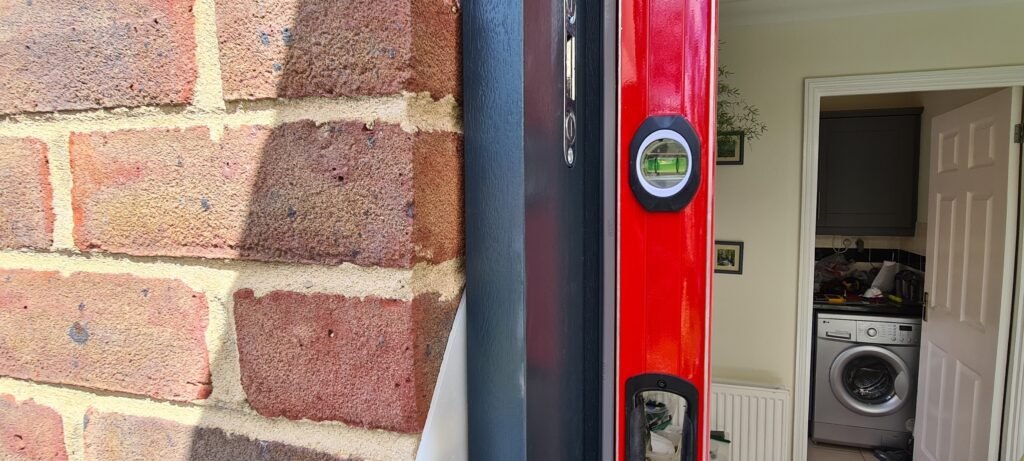
I then used a laser measure with a block of wooden sawn at 45 levels and a white label caught to the face to measure the diagonal distance between the 2 corners of the body. After some jiggling round and rechecking that each one the edges, head and sill had been true I managed to get the readings inside 4mm of one another which was as shut as I used to be going to fairly get.
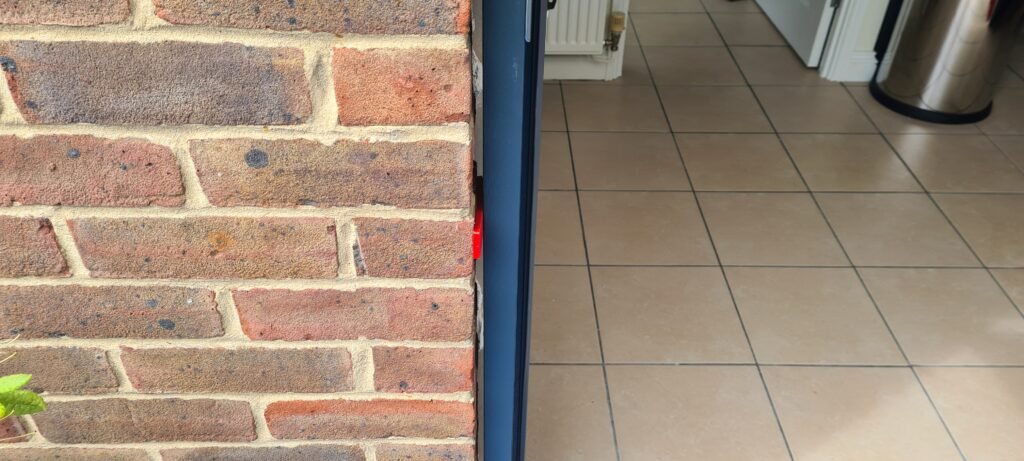
Fixing the body into the opening
I then marked on masking tape caught to the sill the place the metallic tie straps had been going and eliminated the body from the opening laying it down on the ground on blocks of wooden. Utilizing the positions marked on the sill I drilled pilot holes and used my very own self-tapping screws to repair the metallic tie straps in place on the sill.
Now it was time to re-fit the body into the opening hopefully for the final time. With the body in place and the packers inserted again into the positions I had famous above I rechecked the trueness with a spirit degree and in addition checked the measurements diagonally from nook to nook. All was so as, so the subsequent step was to begin drilling the pilot holes for the screws that safe the top however first I simply wanted to safe the sill and cease the body from swinging round on the backside by screwing the screws into the metallic tie straps. I solely partially screwed them in because the sill will rise-up barely when the top is screwed into the lintel.
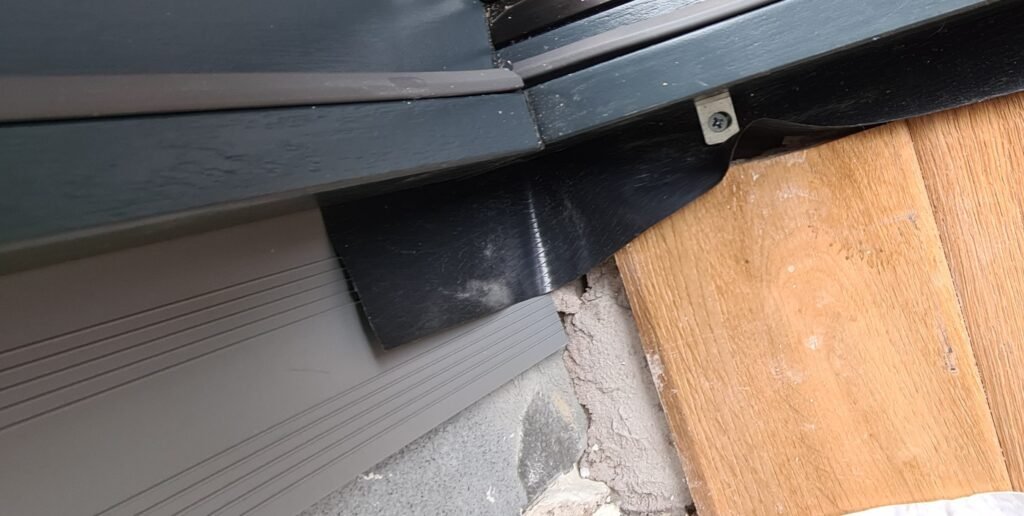
Jeld-Wen stipulate that there should be a bow (or camber as they seek advice from it within the directions) of 5mm within the head between every finish of the top and the center. I’m guessing that is to permit the doorways to run within the monitor with out fouling and they also keep within the appropriate place when absolutely opened. Whenever you have a look at the top it’s laborious to think about it should bend simply contemplating it’s a strong piece of hardwood 80mm by 140mm in thickness however by driving the screws in little by little for every screw working from the skin in it does ultimately develop the required hole at both finish.
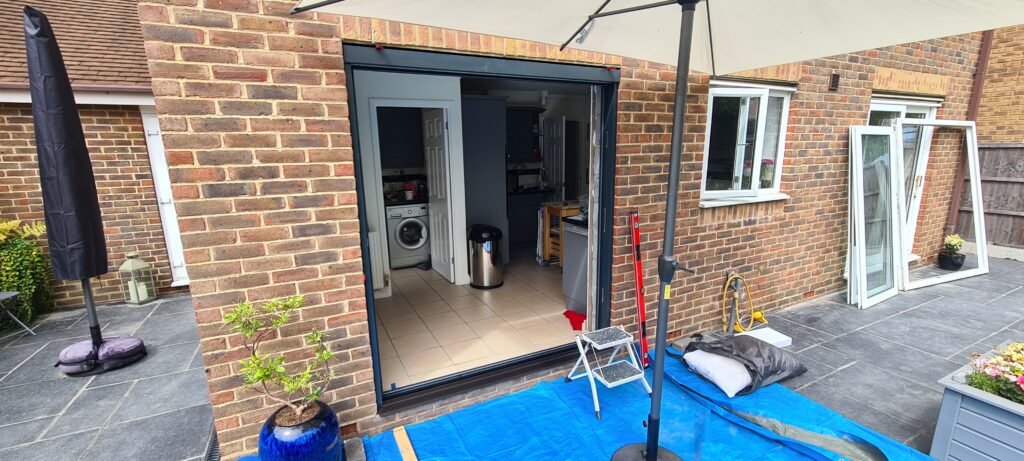
Being cautious to not transfer the body now it’s sq. and true I began drilling the pilot holes by means of the prevailing holes within the head and into the metallic cavity lintel. I used to be cautious to verify the holes had been deep sufficient to simply accept the complete size of the lintel screws that had been equipped. The lintel screws within the pack that Jeld-Wen had equipped required that I drill a 6mm gap by means of the metallic cavity lintel after which to a depth of 80mm within the brickwork above. This meant the drill bit wanted to be a minimal general size of 180mm. This a part of the set up took a while and drilling upwards into the lintel and brickwork above actually gave me exercise as there are 12 screws to place into the lintel.
When the holes had all been drilled within the lintel and brickwork, I used to be prepared to begin driving within the screws. I made certain that some 5mm packers had been positioned on the ends above the top after which some 2mm packers nearly midway to the center earlier than I began step by step driving within the lintel screws. I used to be glad I had consumed a giant breakfast as driving the lintel screws dwelling took some doing. I Stored working from the skin in till the top was tight in opposition to the packers, and I had the specified bow working from then ends of the top to the center.
With the top screwed firmly into place I added some packers beneath the sill to verify it was resting properly on the mortar mattress. It was now time to safe the jambs. This entails drilling 5 equally spaced 6mm holes by means of every jamb utilizing a brad-point wooden drill after which drilling 100mm into the brickwork utilizing an 6mm masonry drill ensuring the outlet was deep sufficient to simply accept the framing screw. The outlet was then countersunk, and the self-tapping framing screws pushed into the brickwork. Earlier than and after driving every framing screw in I stored checking the body for squareness.
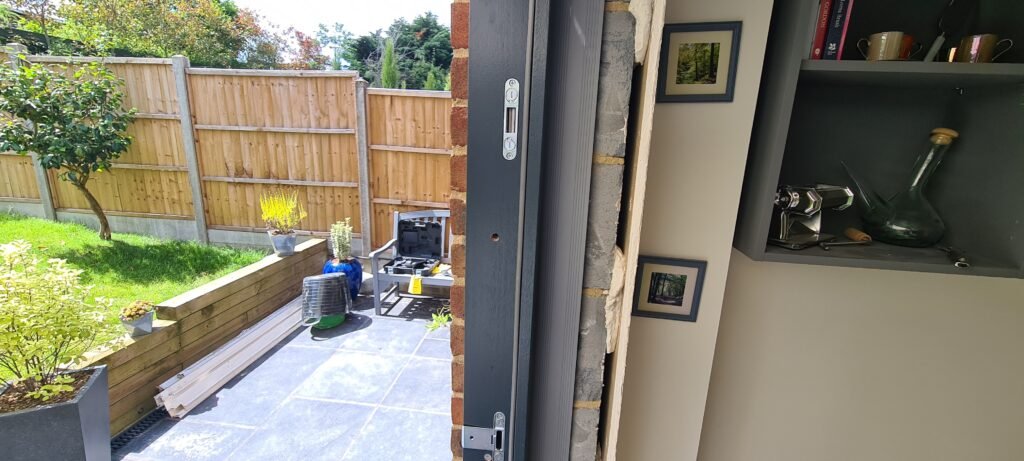
Attending to know the bifold doorways
At this stage I needed to work out if the intermediate provider hinge pivots had been screwed in the best manner spherical for my set up and modify, as obligatory. Now was additionally time to get acquainted with the doorways and place them in the best order and orientation prepared for drilling and becoming.
I went spherical every door making a word of the housings and the way they associated to the door numbers and what manner around the doorways went. Under are the notes that I used to determine every door to make it as straightforward as attainable to pick out the best door within the appropriate orientation when it got here to suit them.
1st Door
– Slide bolt housings on proper at high and backside.
– No climate strip seal on slide bolt aspect.
– Window glazing bars/beads on outdoors.
2nd Door
– 2 Climate strip seals on each side.
– Window glazing bars/beads on outdoors.
third Door
– Multipoint lock on proper.
– Spring latch above deadbolt.
– Spring latch flat aspect dealing with out.
– Climate strip seal on outdoors.
– Deadbolt under spring latch.
– Window glazing bars/beads on outdoors.
Within the installations I carried out the doorways had been hinged to the jamb on the left hand aspect of the body and the multipoint lock was fitted to the door on the best with the hook and latch retains on the right-hand jamb as you look from the within.
Subsequent, I fitted the highest block for the pivot hinge by sliding it up into the cut-out within the monitor and pushing it alongside to the tip. Then I supplied up the fixing plate (it may be a bit fiddly to recover from the spigot within the high block) and marked the place of the screw holes and pilot drilled them with a 3mm common drill bit. The screws that had been equipped within the pack had been too huge for the 3mm pilot holes and would have protruded an excessive amount of additionally to make them match would have required an even bigger pilot gap which in my opinion would have compromised the integrity of the metallic within the monitor, so I used smaller screws. When you have the alternative handing to the way in which I’ve fitted my doorways, then you might have to do the intermediate provider step first (see subsequent paragraph) as a result of the highest block fixing plate will cowl the cut-out within the monitor and cease you from inserting the intermediate provider hinge.

Place the intermediate provider hinge into the monitor through the cut-out at one finish of the monitor and go away it hanging in the midst of the monitor.
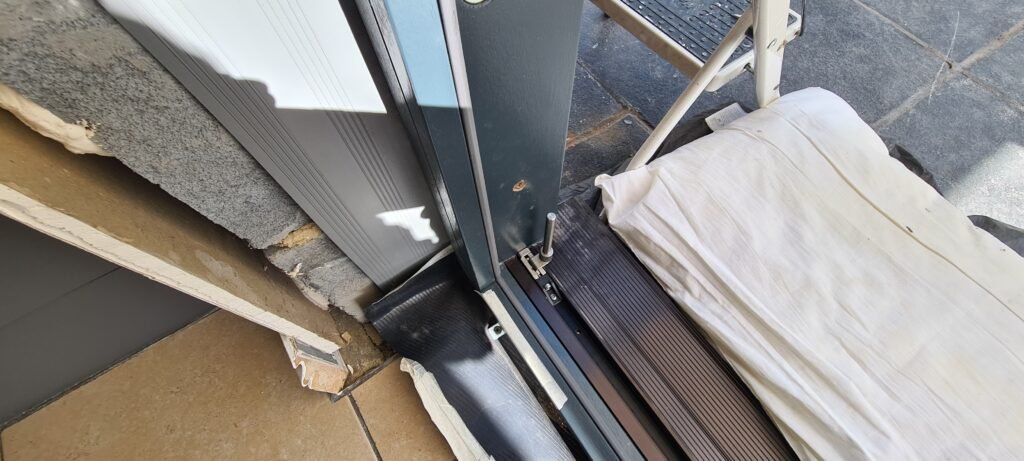
Becoming the hinges
I spent a good bit of time figuring out what hinges went the place checking the directions and pictures on the Jeld-Wen web site.
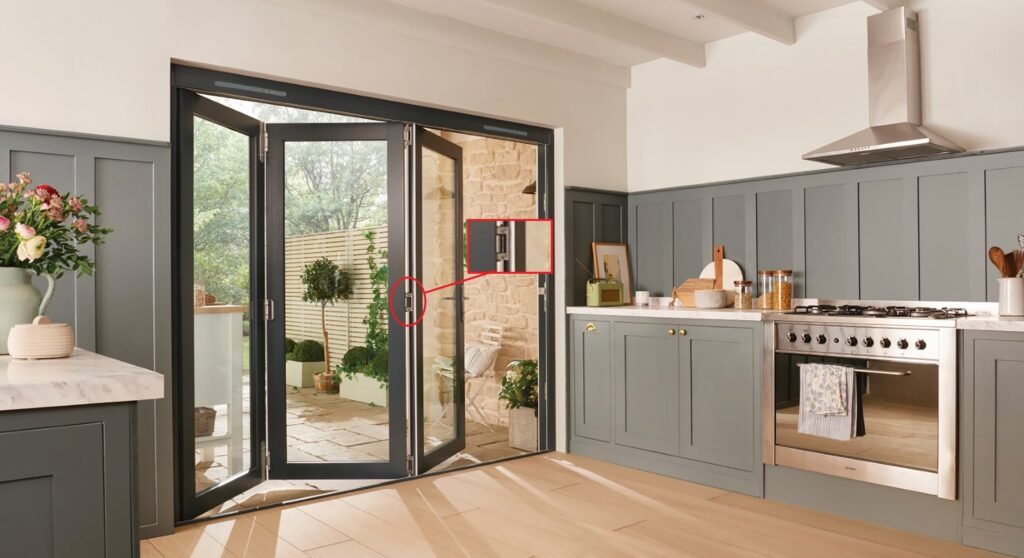
Utilizing the notes within the earlier part to pick out door primary, I positioned it on trestle tables with the glazing bars dealing with up. I eliminated the climate strip from the aspect the place the hinge was going to be hooked up and made a word on some masking tape and caught it around the strip in order that I knew the place it got here from. Utilizing a bit of wooden 15mm thick as a spacer at every finish of the door I positioned the pivot hinge in opposition to the door hinge face laborious up in opposition to the spacer ensuring the knuckle of the hinge was tight in opposition to the door edge and that the hinge was on the proper face and aspect of the door. Holding the hinge firmly with one hand I then drilled the 3mm brad-point bit pilot holes utilizing the hinge as a template. This course of was then repeated for the second pivot hinge. I then drove the screws in utilizing the torx bit equipped with the doorways.

Transferring on to door quantity two, eradicating and labelling the climate strip and putting the door glazing bars dealing with down this time and utilizing a tape measure I measured and marked 60mm from every finish to place the cranked hinge massive leaf aspect in opposition to the face of the door in order that the knuckle was laborious up in opposition to the sting of the door. Holding the hinge firmly in place as a template I drilled the pilot holes and drove within the screws. Then I measured and marked 936.5mm from the highest of the door and glued the center half offset cranked hinge with deal with in the identical manner.
Door two in my configuration has the pivot hinges on the opposite aspect so I flipped the door over on the trestle tables and measured 39mm from the highest and backside of the door and with the knuckle firmly up in opposition to the sting of the skin of the door drilled and screwed the small leaf of the hinges, with the three screws, into place. The provider hinge being on the high and the intermediate information hinge on the backside. Then I measured 960.5mm and drilled and screwed the small leaf of the center flat hinge into place.
Hanging the doorways
Now with all of the hinges mounted on the doorways they had been able to be hung into place. This undoubtedly required the providers of two individuals. The primary door to hold was door primary. The important thing to a simple set up is for one particular person to carry the door in place having positioned the underside hinge over the pivot publish and resting it in an upright place and the opposite particular person guides and screws the highest pivot bolt into the highest block housing. The yellow plastic lock ring must be screwed on the pivot bolt to cease it falling out of the hinge cylinder whereas the door is being positioned. I used an 8mm ball finish allen key hex bit fitted to a socket adapter and extension on a sq. ended socket screwdriver to make the changes to the pivot bolt.
Subsequent, I hung the second door. It is a related course of to the primary door however this time, nonetheless utilizing two individuals, we positioned the intermediate information into the gully within the sill and holding firmly onto the door positioned the intermediate provider hinge under the housing and whereas one particular person steadied the door the opposite particular person screwed the bolt up into the provider housing.
Whereas one particular person maintained a agency grip on the door the opposite particular person used a hydraulic jack raised up under the 2 doorways with a bit of flat wooden in-between the jack and the doorways simply touching the underside of each doorways to verify they remained collectively on the similar top. Then the small leaf of the cranked hinges was positioned in opposition to the face of door one and used as a template to drill pilot holes after which drive dwelling the torx screws.
To hold the third door requires making a platform to help the door whereas it’s screwed into place. As per the second door we used a hydraulic jack to lift and help the third door to the peak of door one and two. Different methods to deliver door three to the proper top could be bricks, kitchen steps or blocks of wooden whereas utilising packers to achieve the specified top. As soon as door three was on the appropriate top one in every of us steadied the door whereas the opposite made certain the big leaf of the door two hinges had been flat in opposition to door face and drilled and screwed the hinges into place.
Then I pushed the climate strips again into their channels on the doorways ensuring to get the proper climate strip into the best groove and the best manner spherical (There are three varieties of climate strip with completely different profiles). The strips must be minimize to dimension the place they butt upto a hinge. There are some small strips of 15mm on the finish of some doorways the place there’s a small hole on the high between the hinge and the highest of the door.
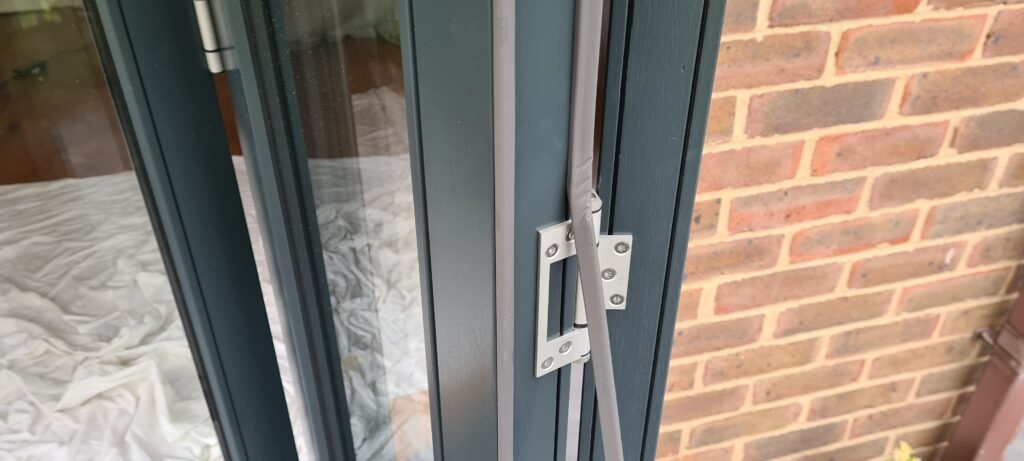
Adjusting the doorways
We’re on the homeward stretch having mounted the body and hung the doorways. The following job was to regulate them to verify the gaps on the high, backside and sides are set to the proper tolerances. Utilizing an extended attain massive dimension screwdriver I adjusted the screws within the high and backside block in order that the aspect gaps had been parallel and round 8mm on the multipoint lock finish.
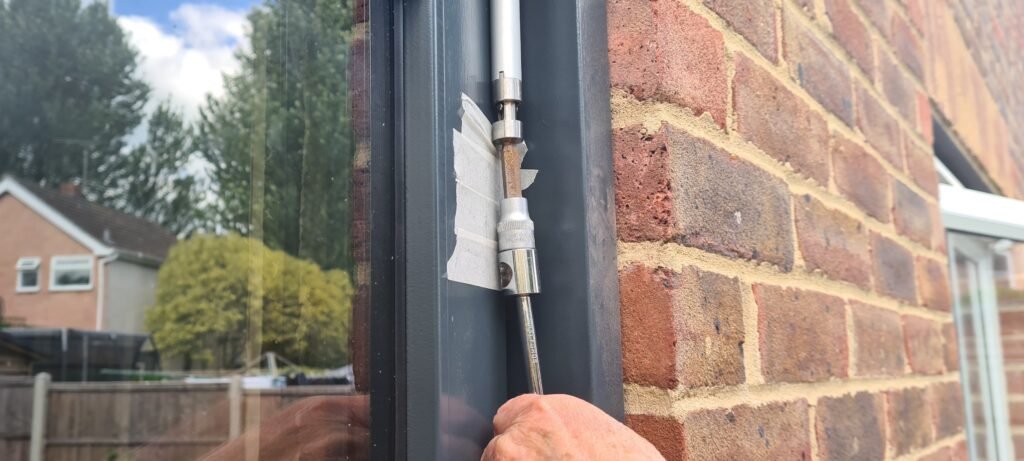
Utilizing the ball finish allen key I adjusted the pivot block and intermediate provider bolts in order that the hole alongside the highest and backside of the doorways between the door and sill and door and head was about 5mm.
Fixtures and fittings
The doorways now have match within the body so that is once I added the fixtures and fittings. First the retains within the jamb that may settle for the multipoint lock latches, deadbolts and hooks. For my installations the blanking plates and retains had been around the fallacious manner so I needed to swap them over remembering to swap the spacers as properly that go behind the blanking plates. Then I fitted the drop-bolts which must be fitted with the one screw accessible by means of the outlet within the slide when the slide is 2 thirds down or up depending on whether or not it’s the backside or high one.
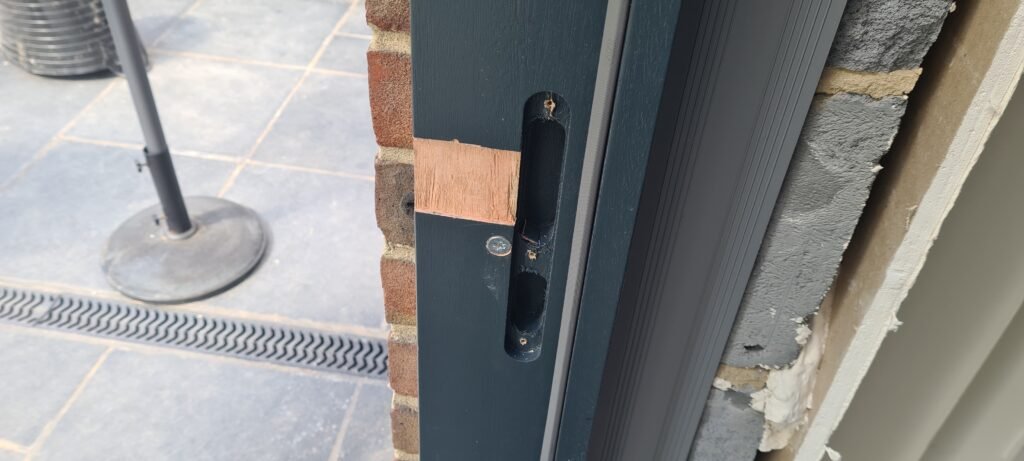
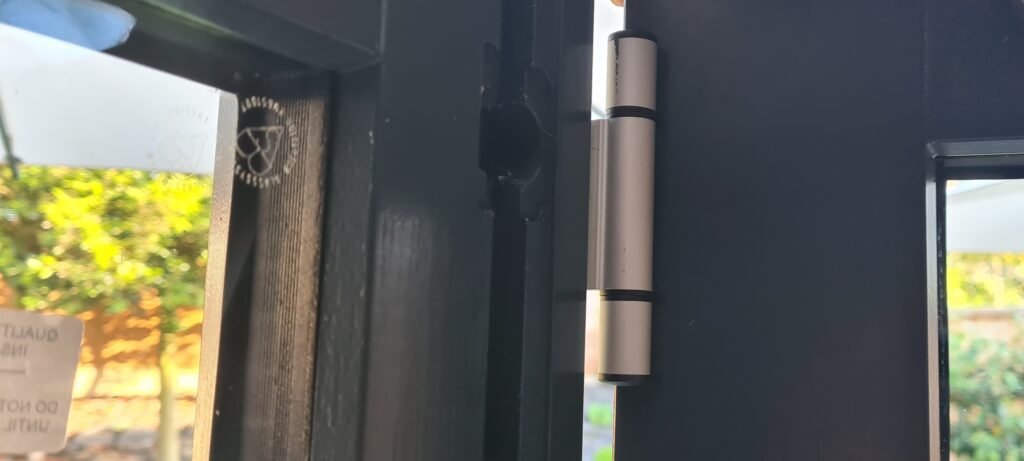
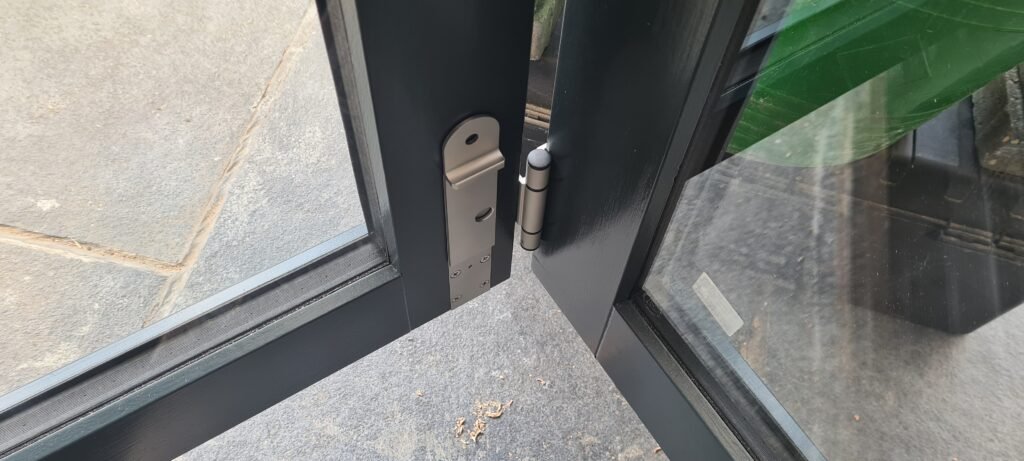
Final fixture to be fitted is the deal with. For this I made a template up utilizing the deal with as a template. The 2 bolts that screw the deal with collectively I drilled utilizing a 12mm brad-point drill bit. For the keyhole I drilled a big 20mm gap and a smaller 12mm gap one above the opposite and joined them up by reducing the edges out with a multitool fitted with a wooden plunger. I painted the freshly drilled timber with some exterior wooden paint that matched the color of the doorways which was Anthracite Gray RAL 7016. Then after permitting the paint to dry for some time it was a case of becoming the deal with with spindle and screwing within the bolts.
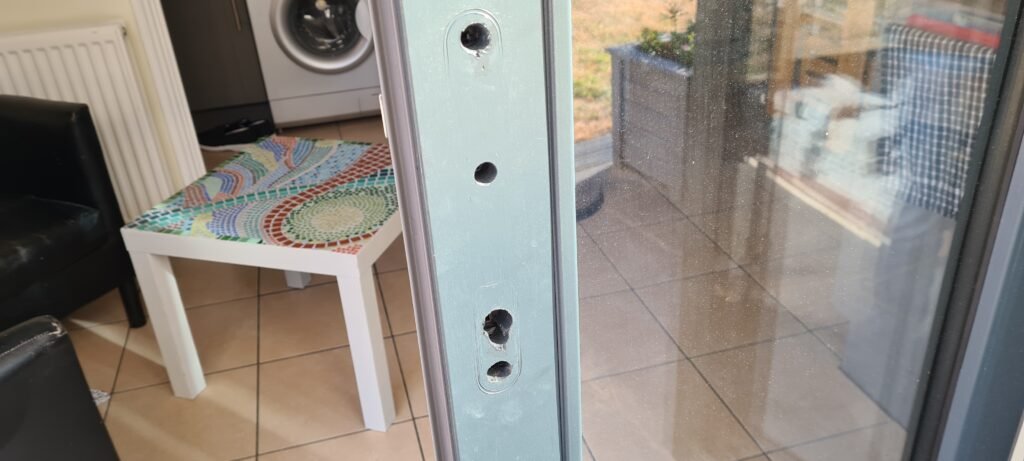
Remaining changes to the doorways
It was time to see if the multipoint lock was lined up with the retains and if that’s the case would the doorways shut correctly? I pulled the doorways shut throwing the drop bolts high and backside and tried to drag the deal with up on the multipoint lock. It didn’t need to go so now its was a case of figuring out the place it was binding with the retains.
It was simpler to drag the climate strip off the third door so I may see the trail of the latch, deadbolt and hooks once I pulled the deal with up. The deadbolt and latch had been binding on the aspect of the preserve and weren’t being allowed to penetrate the preserve. There was adjustment on the latch preserve however none on the deadbolt preserve. I adjusted the latch preserve and that now went absolutely dwelling into the preserve however the deadbolt was nonetheless binding. Regardless of how laborious I pulled the door into the body I couldn’t get the deadbolt to close. The one choice was to shave a few of the aspect of the deadbolt preserve away which I did and that allowed the deadbolt to go all the way in which into the preserve.
The hook on the high of the multipoint lock was additionally catching on the highest of the preserve so I dropped the doorways down ever so barely by screwing the bolts down on the provider and intermediate hinges. This allowed the highest hook to have interaction within the preserve however now the underside hook was binding on the preserve plate. There is no such thing as a vertical adjustment on the preserve plates so it seemed like the one choice was to machine a bit of little bit of metallic off the underside fringe of the decrease preserve plate. I eliminated it from the jamb and used a cone formed metallic rotary rasp in an electrical drill to take away a few of the preserve plate decrease edge. Eradicating about 1.5mm was sufficient to permit the lock to work correctly and now the doorways function very easily. I did apply some white lithium spray over the hinges and within the provider and monitor to assist operation and assist protect the end over time in opposition to the weather.
Making good
The equipment equipped by Jeld-Wen comes with a variety of white and brown screwcap covers. I’m undecided why they’re included within the fixtures and fittings pack as they don’t match any of the colors which can be used within the manufacture of the doorways. I bought some massive flat 20mm disk screw cap covers that had a slight grainy texture to them. Though they had been gray the match was not good for the color of the body so I glued them over the ten framing screws within the jambs after which painted them with the Anthracite Gray RAL 7016 paint that I already had.
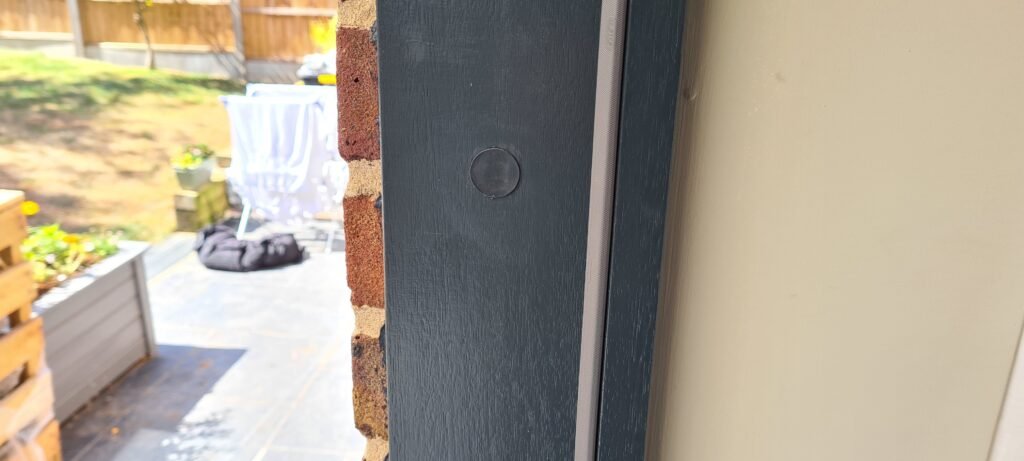
Subsequent on the make-good checklist was the dry wall across the opening. For this I nailed up some battening simply to present the drywall some structural stability on the junction with the body as I wasn’t planning to place any cloaking strips spherical the skin, so I wanted to verify there have been no gaps or play within the drywall. I butted the drywall as much as the outdated dry wall and the plastered the joint to type an exterior nook. I then ran a bead of CT1 down the joint between the drywall and the body and smoothed it over with my index finger dipped in water.
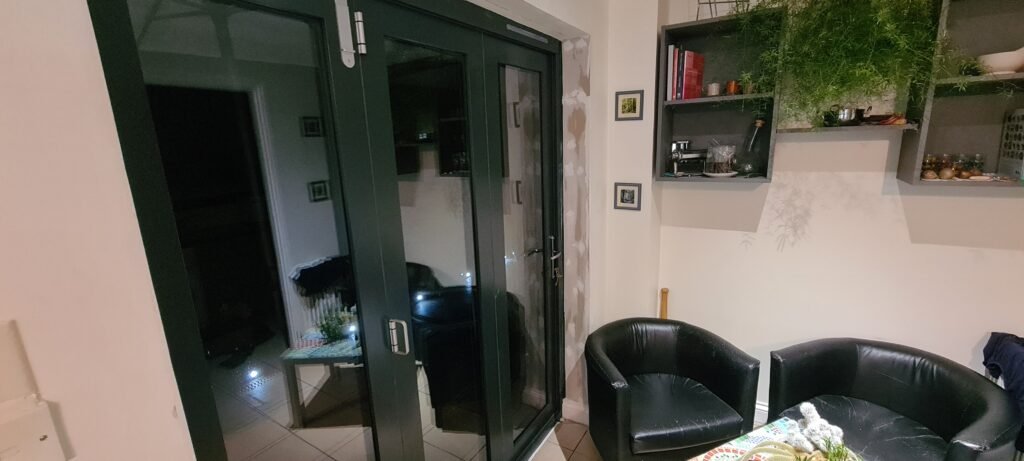
As soon as the plaster was dry I minimize up the 4 skirting boards which in my case had a profile referred to as Ogee after which dot and dabbed them into place and stuffed within the gaps with some filler.
When the filler that I had used to fill the gaps within the skirting board was dry I gave the boards a fast sand down simply to take away any blemishes after which it was prepared for paint. A few coats of primer after which two of the topcoat gave end on the partitions and primer and white gloss on the skirting boards.
The ultimate a part of the undertaking was to chop the cloaking strip, which I managed to supply with an Anthracite Gray end that matched the doorways fairly properly, to size and stick it down over the joint between the tile that had been minimize with the grinder and the body utilizing some CT1 sealant.
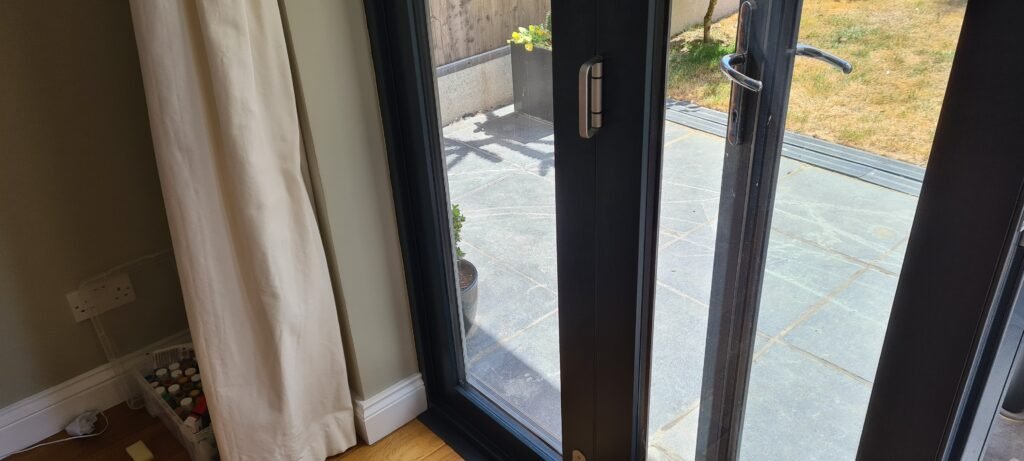
The method was considerably complicated requiring precision and endurance and a alot of effort in locations however the finish outcomes had been each rewarding and satisfying.
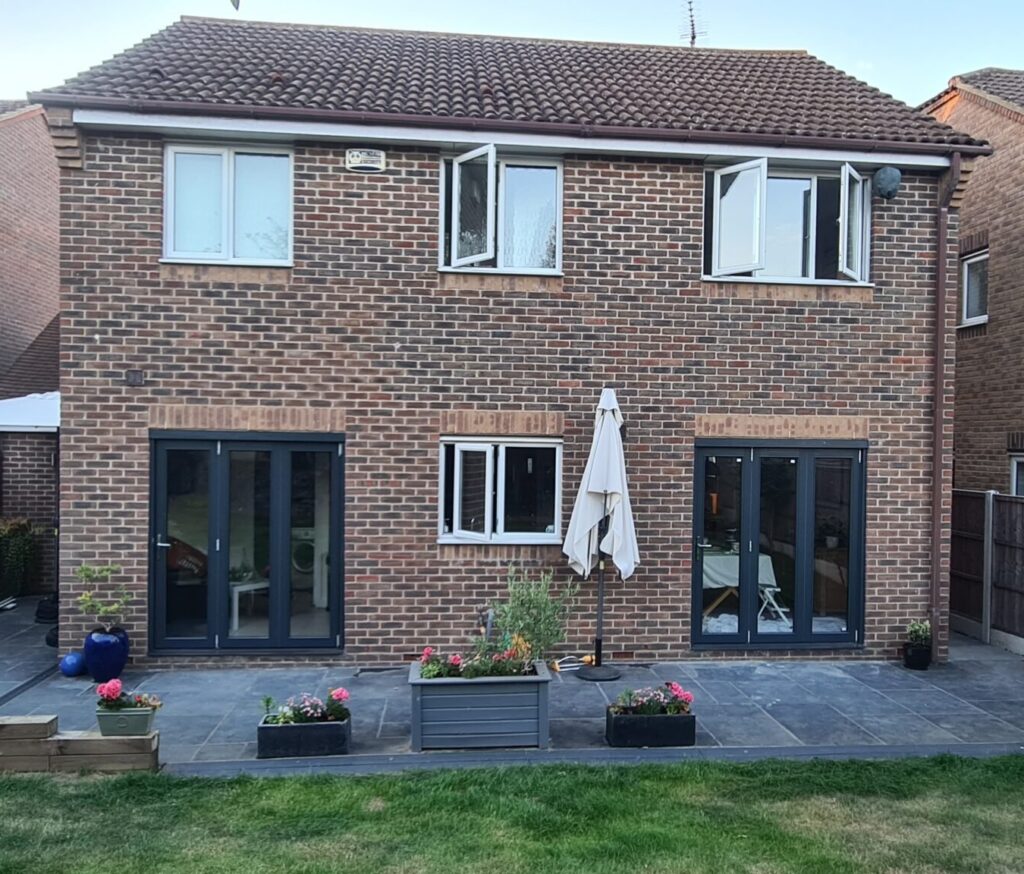
[ad_2]
